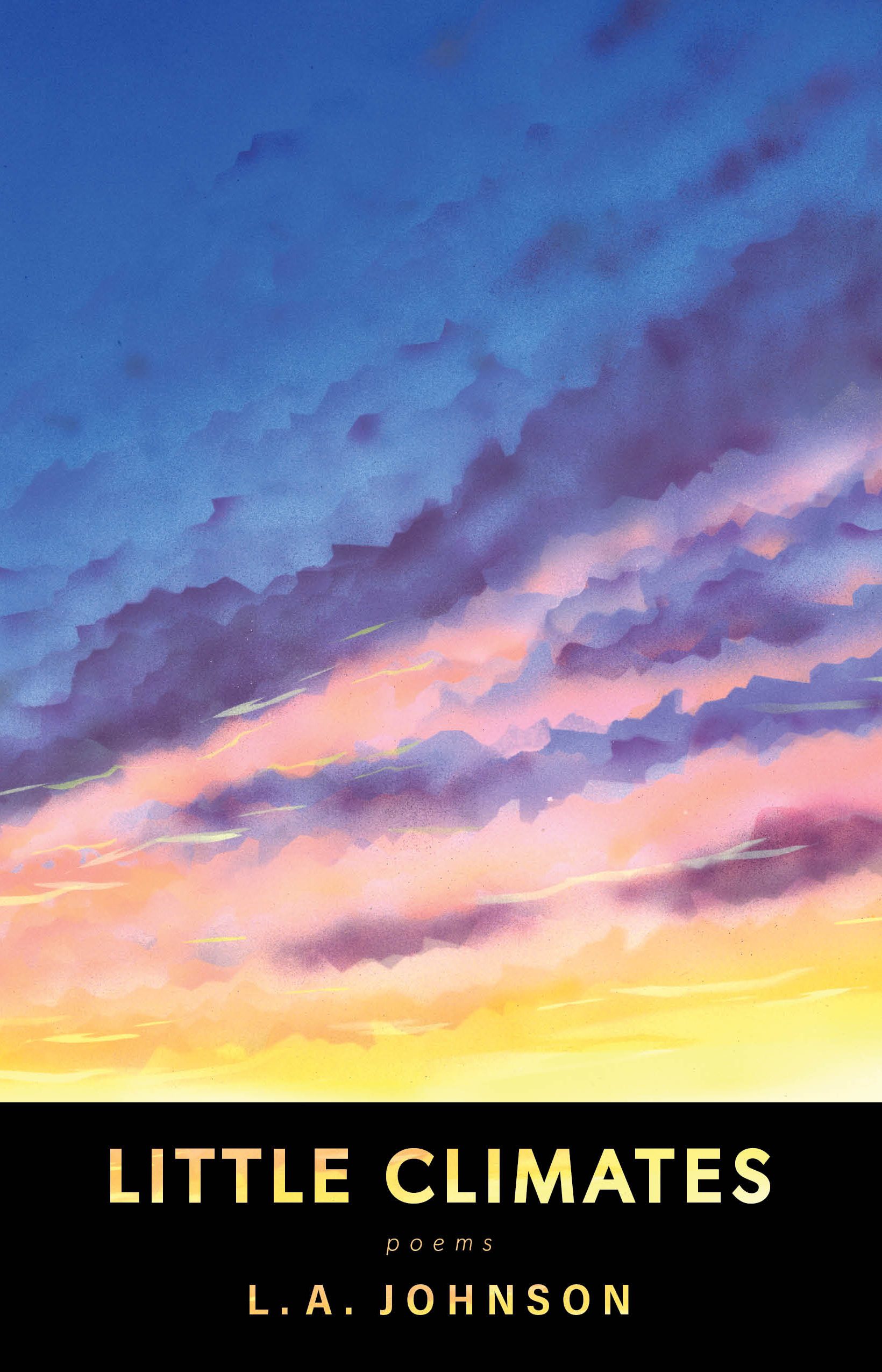
The poems of L. A. Johnson, author of last year’s chapbook Little Climates, feel slick and buffed—but beneath their careful polish the lyric poems explore densely complicated “little climates,” with tight, knot-like logic.
There’s something more pernicious than initially meets the eye; lyric has a pleasing sound but gestures toward a scenario braided with taut conflict, in lines like, “the walls confine/the regular angers” or “In the freezer, always, only the notion of an icebox cake—its layers/softening to be like the real thing.”
In December, just after the launch of Little Climates, I Skyped with Johnson, and we talked about deer, the relationship between visual art and poetry, and the California fires.
***
The Rumpus: Little Climates seems like an apt name to me for your chapbook, because you move through what you call “microclimates,” and navigate different spaces, but tight spaces.
L. A. Johnson: I can’t remember where exactly the title came from, but it was always called Little Climates. The title stuck even as the chapbook changed because, as you were saying, there are a lot of different climates—domestic spaces and the landscapes of California. The book’s construction also contains certain “climates” in its forms. The two “Shapeshift” poems embody the idea little climates. They each have small parts with separate climates within the whole poem.
Rumpus: The climate in the chapbook’s first poem, “Epistemology,” is a domestic space, then exits that space and leads you into the rest of the book.
Johnson: Little Climates speaks to the idea of the lyric poem. Lyric allows you to cross different boundaries of spaces or “climates.” These poems seem placid on the surface—“Epistemology” can seem to be only in a domestic space, but the lyric allows you to slip out of that space almost without realizing it. The poem goes not quite to a surreal place but to a dramatic place, with stray cats at the porch and this imaginary space about the icebox cake. Lyric allows you to move while thinking you’re in one space.
Rumpus: “Epistemology” starts in quatrains. The “Shapeshift” poems are in tercets, in little units. There’s a formal logic. And the idea of a stanza as a room, that’s also its own “little climate.”
Johnson: The “Shapeshift” poems are sister poems. It’s unusual that they’re close together. They used to be farther apart. They embody the little climates, and the poems get filtered through the “Shapeshifts” and take a dramatic shift, as far as the scope of the collection. Each section in “Shapeshift” does a different thing. That’s another thing with lyric poems; they allow border crossing between what’s considered the natural world and what’s considered more human or domestic space. The second one starts with confusion, between what is seen in the natural world and the threat in the interior world. The other sections collide natural images and romantic images. I see these poems as marking shifts that change the way the poems are read.
Rumpus: In “Provenance” you write, “it’s July; it could be any season.” There’s a mutability of what we take for granted. You investigate this confusion between this natural landscape and the domestic ones. It troubles what each of those mean to us, especially in a lyric space, and how they’ve traditionally been rendered.
Johnson: This poem imagines a space deep in the ocean, where two humans can be together. It takes a natural space and makes it strangely domestic.
Rumpus: In “Forecast,” as well, the speaker’s in a glass-bottomed boat and looking down into the water, but there are trees in the water. You create spaces that don’t exist.
Johnson: It’s what the lyric poem can do. It makes me think of the “I-thou” relationship, which is a function of lyric poems. There’s a mutability of “who is the I” and “who is the thou.” To me, this question plays into how you interpret the switching of domestic or natural space.
Rumpus: I think your poems are troubled by these apparitions of other characters. I saw the reoccurring deer as an avatar, operating in tandem with the I-thou relationship. There are other moments where I sensed a shift in the address of the poems. The “you” is never named, for example, so there’s a way in which the reader becomes implicated in each of these different “you’s.” Confusion is a word you used, but I think it’s a little more elegant than that.
Johnson: It’s part of the mutation. I just did a launch reading, and as I was selecting poems to read, I realized there are so many animals because it’s this “switch” with the natural world. That’s why there are so many deer. The animal sometimes fills that space of the thou. One of my favorite poems from this chapbook is “Night Passage.” In the poem, the speaker and the deer are conflated. As though the deer, who is never seen, is the human, or equal to the human speaker.
Rumpus: I see this happening in other parts of the book, like in “Self-Portrait as Norway Spruce” for example, or even in “Fall, Backwards” when the speaker says “I am the woman in profile.” In these poems, the “you” is sometimes the “I.”
Johnson: A number of these poems are not quite ekphrastic poems, but ekphrastic inspired. I wrote a number of them in response to Richard Diebenkorn’s paintings, many of them abstract landscapes in California. A number of these poems, including “Fall, Backwards,” were written looking at these landscapes and using it as an imagined setting for these emotions to be explored, imagining the artistic space as the real space. What drew me to these paintings was that they were abstract, but they felt like my both real and imagined spaces, as a die-hard Californian.
Rumpus: That seems like the perfect space for lyric exploration. I want to ask you about Boyang Hou’s cover art. How did the ekphrastic mode of you looking at a painting translate to a painter looking at your art and making a cover?
Johnson: We talked about the chapbook and he read it. A theme I’m really interested in is mirroring and refraction. Somewhat like what I was saying about the prisms in “Shapeshift.” Mirroring interests me formally in the poems and as a concept. Many of these poems have this expectation of the thou as a mirror, but they’re not. The mirror is broken in a fundamental or irreparable way. So Bo made this painting and then my editor flipped it on the back cover, so it looks mirrored and refracted.
Rumpus: So many of Bo’s skyline paintings are in conversation with photos that people take of the sky with their cellphones, which is another type of refraction, in a way.
Johnson: Yes, this was based off a photo he had taken. But I like that it’s a painting. I didn’t want the cover to be a photographic image. The book deals with climate change, but it’s not an ecopoetics climate change book. A photographic image wouldn’t be true to the book, and so I wanted something painted. What do you think of the cover?
Rumpus: It’s beautiful. And it’s real enough. It fits the chapbook. There’s this threat of climate in your book. I’m thinking of your last poem “Continuum” where you write, “the snow arrived too early. A pair of deer caught in a squall of white.” A little climate is a threat. Something can happen in one space that doesn’t happen in another.
Johnson: There are a lot of different seasons and climates in the book. This book only mentions California a few times but all the landscapes are Californian landscapes. They’re the only landscapes that I know. And here, looking out my window, I can see the fires of Southern California. Right now California is burning and yet there’s snow on mountains that I can also see from my window. It has diverse ecosystems. This makes the state wonderful but also means there a lot of threats because anything could happen.





